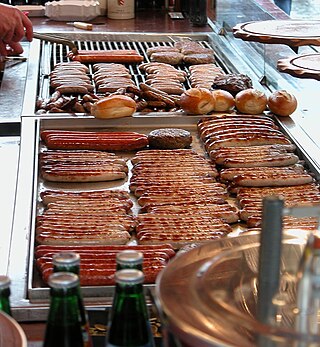
Extrawurst can be either a type of cold cut or part of a German idiomatic expression.

Extrawurst can be either a type of cold cut or part of a German idiomatic expression.
Extrawurst is a type of Austrian scalded cold cut. It is moist, light-coloured, fine-textured, and made from a well-spiced mixture of beef, pork and bacon fat. [1] In Austria, it is the most popular type of cold cut. [2]
It is similar to the American Bologna sausage, the Dutch Boterhamworst , the German Lyoner or Fleischwurst and the Swedish Falukorv .
It is cooked or served cold, often in a Wurstsalat, or as a cold cut.
One variety is the Pikantwurst, which has finely chopped red or green peppers added to it. Another type of Extrawurst called Gurkerlextra containing small chunks of pickled cucumber is also available.
Extrawurst is also a frequently used German expression of disapproval [3] relating to someone wanting or receiving special treatment. One would say "er will immer eine Extrawurst gebraten haben" or "er bekommt eine Extrawurst gebraten" ("he always wants [or "he gets"] an additional/special sausage grilled/fried for him") to express that someone wants or gets something out of the ordinary.

The cuisine of Germany consists of many different local or regional cuisines, reflecting the country's federal history. Germany itself is part of the larger cultural region of Central Europe, sharing many culinary traditions with neighbouring countries such as Poland and the Czech Republic. In Northern Europe, in Denmark more specifically, the traditional Danish cuisine had also been influenced by German cuisine in the past, hence several dishes being common between the two countries.

A sausage is a type of meat product usually made from ground meat—often pork, beef, or poultry—along with salt, spices and other flavourings. Other ingredients, such as grains or breadcrumbs may be included as fillers or extenders.

Hungarian or Magyar cuisine is the cuisine characteristic of the nation of Hungary, and its primary ethnic group, the Magyars. Hungarian cuisine has been described as being the spiciest cuisine in Europe. This can largely be attributed to the use of their piquant native spice, Hungarian paprika, in many of their dishes. A mild version of the spice, Hungarian sweet paprika, is commonly used as an alternative. Traditional Hungarian dishes are primarily based on meats, seasonal vegetables, fruits, bread, and dairy products.

A hot dog is a food consisting of a grilled or steamed sausage served in the slit of a partially sliced bun. The term hot dog can refer to the sausage itself. The sausage used is a wiener or a frankfurter. The names of these sausages commonly refer to their assembled dish. Hot dog preparation and condiments vary worldwide. Typical condiments include mustard, ketchup, relish, onions in tomato sauce, and cheese sauce. Other toppings include sauerkraut, diced onions, jalapeños, chili, grated cheese, coleslaw, bacon, and olives. Hot dog variants include the corn dog and pigs in a blanket. The hot dog's cultural traditions include the Nathan's Hot Dog Eating Contest and the Oscar Mayer Wienermobile.

Bratwurst is a type of German sausage made from pork or, less commonly, beef or veal. The name is derived from the Old High German Brätwurst, from brät-, finely chopped meat, and Wurst, sausage, although in modern German it is often associated with the verb braten, to pan fry or roast. Beef and veal are usually incorporated amongst a blend often including pork.

Danish cuisine originated from the peasant population's own local produce and was enhanced by cooking techniques developed in the late 19th century and the wider availability of goods during and after the Industrial Revolution. Open sandwiches, known as smørrebrød, which in their basic form are the usual fare for lunch, can be considered a national speciality when prepared and garnished with a variety of ingredients. Hot meals are typically prepared with meat or fish. Substantial meat and fish dishes includes flæskesteg and kogt torsk with mustard sauce and trimmings. Ground meats became widespread during the industrial revolution and traditional dishes that are still popular include frikadeller, karbonader and medisterpølse. Denmark is known for its Carlsberg and Tuborg beers and for its akvavit and bitters, but amongst the Danes themselves imported wine has gained steadily in popularity since the 1960s.

A butcher is a person who may slaughter animals, dress their flesh, sell their meat, or participate within any combination of these three tasks. They may prepare standard cuts of meat and poultry for sale in retail or wholesale food establishments. A butcher may be employed by supermarkets, grocery stores, butcher shops and fish markets, slaughter houses, or may be self-employed.

Austrian cuisine is a style of cuisine native to Austria and composed of influences from Central Europe and throughout the former Austro-Hungarian Empire. Austrian cuisine is most often associated with Viennese cuisine, but there are significant regional variations.

A hot dog bun is a type of soft bun shaped specifically to contain a hot dog or another type of sausage.

Gelbwurst, meaning “yellow sausage”, is a traditional sausage and deli meat from Bavaria, Germany.

Different areas of the world have local variations on the hot dog, in the type of meat used, the condiments added, and its means of preparation.
Luxembourg's cuisine reflects the country's position between the Latin and Germanic countries, influenced by the cuisines of neighbouring France, Belgium and Germany. Recently, it has been influenced by the country's many Italian and Portuguese immigrants. As in Germany, most traditional, everyday Luxembourg dishes are of peasant origin, in contrast to the more sophisticated French fare.

The Carniolan sausage is a Slovenian sausage similar to what is known as kielbasa or Polish sausage in North America.

Battered sausages are a type of sausage found all across the United Kingdom, Ireland, Australia and New Zealand.

Wurstsalat is a tart sausage salad prepared with distilled white vinegar, oil and onions. A variation of the recipe adds strips of pickled gherkin. It is generally made from boiled sausage like Lyoner, stadtwurst, Regensburger Wurst or extrawurst. It is a traditional snack in Southern Germany, Alsace, Switzerland and Austria.

Important parts of Faroese cuisine are lamb and also fish owing to proximity to the sea. Traditional foods from the Faroe Islands include skerpikjøt, seafood, whale meat, blubber, garnatálg, Faroese puffins, potatoes, and few fresh vegetables.


Kabanos, also known as cabanossi or kabana, is a long, thin, dry sausage usually made of pork which originated in Poland. They are smoky in flavor, and can be soft or very dry in texture depending on freshness. Typically, they are quite long, 60 cm (24 in), but very thin, with a diameter around 1 cm (0.39 in), and folded in two, giving them a characteristic appearance. Versions made of chicken and turkey are staples in kosher meat markets and delicatessens.

Kielbasa is any type of meat sausage from Poland and a staple of Polish cuisine. In American English the word typically refers to a coarse, U-shaped smoked sausage of any kind of meat, which closely resembles the Wiejskasausage.